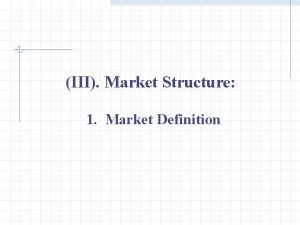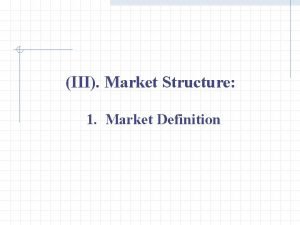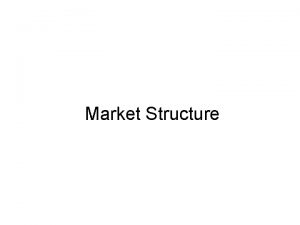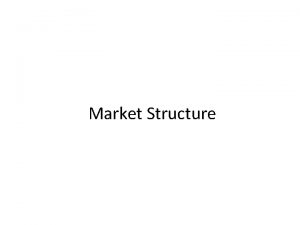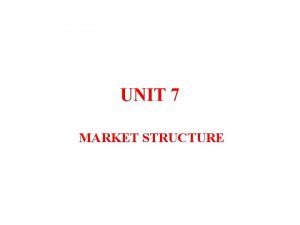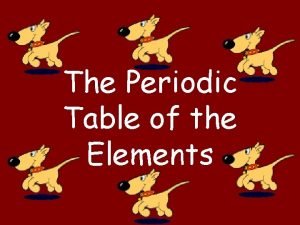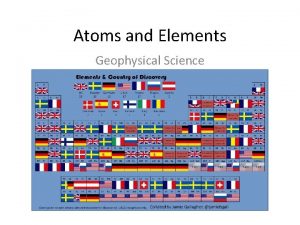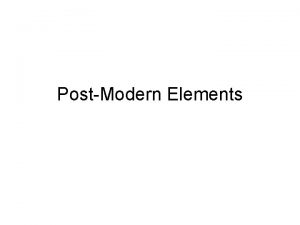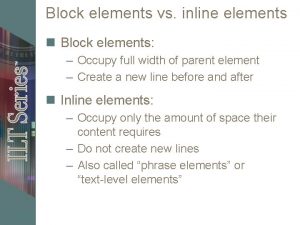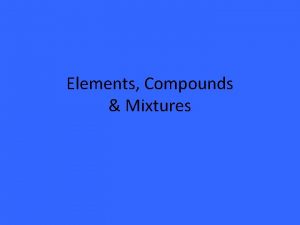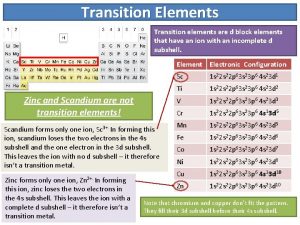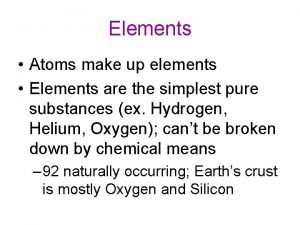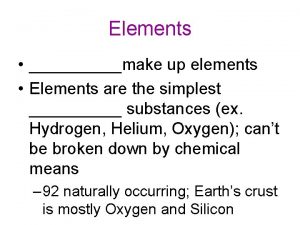III Market Structure 2 The Elements of Market











































- Slides: 43

III. Market Structure: 2. The Elements of Market Structure

III. Market Structure 2. The Elements of Market Structure -(1). Market Imperfection -(2). Categories of Markets -(3). Degrees and Concepts of Partial Competition -(4). The Meaning of Market Structure -(5). The Elements of Market Structure

III. Market Structure: 2. The Elements of Market Structure -(1). Market Imperfection (69) -i. Perfect competition involves pure competition in which 1. there a large number of buyers an sellers of 2. homogeneous product with 3. no obstacles to entry or exit of firms plus certain strict assumptions, as follows: 4. perfect knowledge, 5. perfect mobility, 6. rational behavior, 7. no nonmarket interdepenences, 8. market is always clear.

2. The Elements of Market Structure -(1). Market Imperfection (69) -ii. Categories of Market Imperfections: *Barriers Against New Competition – 3 *Consumer Loyalties May Exist – 2 *Differences in Access to Information, Including Secrecy – 4 *There May Be Large Uncertainties – 4 -8 *Risk Aversion – less competitive *Transactions Costs May Be Significant – 4 -8 * Consumers May Exhibit Irrational Behavior – 6 : :

2. The Elements of Market Structure -(2). Categories of Markets Ineffective Competition: Competition i. Monopoly ii. The Dominant Firm iii. Tight Oligopoly Effective Competition: Competition i. Loose Oligopoly ii. Monopolistic Competition iii. Pure Competition

-(3). Degrees and Concepts of Partial Competition -i. Ineffective Competition: -(i). Monopoly MR = MC

-(3). Degrees and Concepts of Partial Competition -i. Ineffective Competition: -(ii). The Dominant Firm: its power over the market is less than complete. A. Schumpeter’s Competitive Process: Transient Dominance? An process of dynamic disequilibrium: competition and progress occur together, i. e. , the cycle of creative destruction continues. ( the exact reverse of the neoclassical analysis of monopoly ) ↑ Passive Dominant Firms ? ? ? ( Be vulnerable enough? Easy entry? Max LRπ? ) * * Dominance is usually ineffective competition. Persistent Dominance: i. Higher prices, ii. Price discrimination.

-(3). Degrees and Concepts of Partial Competition -i. Ineffective Competition: -(ii). Dominant Firm

-(3). Degrees and Concepts of Partial Competition -i. Ineffective Competition: -(iii). * Tight Oligopoly: collusion is likely. ◎ The main lines of the topic are as follows: i. Oligopoly is about fewness and interdependence ii. There is indeterminancy. iii. Strategy is required. iv. Oligopoly also means a wide range of outcomes. v. The oligopolists always have mixed, conflicting incentives between competing and colluding.

-(3). Degrees and Concepts of Partial Competition -i. Ineffective Competition: -(iii). * Tight Oligopoly: ◎ collusion is likely. Conditions facilitae coordination: i. High Concentration. iii. Familiarity over time. ii. Similarity of the Firms’ Conditions. ◎ Types of Coordination: i. Cartel. ii. Tacit Collusion.

-(3). Degrees and Concepts of Partial Competition -i. Ineffective Competition: Tight Oligopoly -(iii).

-(3). Degrees and Concepts of Partial Competition -ii. Effective Competition: -(i). Loose Oligopoly : collusion is not likely. -(ii). Monopolistic Competition Each firm has a slight degree of monopoly power, as follows: i. There is some product differentiation ii. There is free entry. iii. There is no interdependence among individual firms. -(iii). Pure Competition

-(3). Degrees and Concepts of Partial Competition

STRUCTURE - BEHAVIOR - PERFORMANCE

2. The Elements of Market Structure -(4). The Meaning of Market Structure Market structure is the economically significant features of a market which affect the behavior of firms in the industry supplying the market. The differences between market forms matter, because they affect the performance of the economy.

-(5). The Elements of Market Structure -i. *Market Share ( the leading element ) : -ii. *Concentration: -iii. *Product Differentiation -iv. *Barriers to Entry : -(i). Scale-Economy Barriers to Entry -(ii). Absolute-Cost Barriers to Entry -(iii). Product-Differentiation Barriers to Entry -(iv). Capital Requirement Barriers to Entry -v. International Trade -vi. Other Elements of Market Structure: -(i). Demand Growth -(ii). Buyer Concentration -(iii). Barriers to Exit -(iv). Others

-(5). The Elements of Market Structure -i. *Market Share ( the leading element ) : (71) Performance= f( Structure ) Share↑→ Market Power↑→ π↑ >15% , market power appears 25 -30% , the degree is significant >40 -50%, market power is strong ( Microsoft and Procter & Gamble ) Rate of Return = a + b market share, b>0 a: the cost of capital to the firm, b: the slope of the line

-(5). The Elements of Market Structure -ii. *Concentration: 4 -(i). CR k : the k-firm concentration ratio CR 4 = Σ Si i=1 CR↑→ Market Power↑, Easier to Collude → π↑ ◎The concentration ratio is a measurement tool which takes account of both the number and size distribution of firms in a market, yet presents the results in a form simple enough that it is easy to interpret.

-(5). The Elements of Market Structure -ii. *Concentration: k -(i). CR k : the k-firm concentration ratio CRk = Σ Si i=1 4 -(i). CR k : the k-firm concentration ratio CR 4 = Σ Si i=1 Concentration shows directly the degree of oligopoly, but the combined market power is simply a diluted version of the dominance of a single firm with that market share can exert. ◎ ◎ Kwoka (1979, 1981 )

-(5). The Elements of Market Structure -ii. *Concentration: (71) -(ii). The HHI ( the Hirschman-Herfindahl Index ) : (74) it has been hard to interpret. The HHI is the sum of squared market shares of all firms in the market. e. g. 5 firms, shares: 30%, 25%, 20%, 15% and 10% HHI = (30)+(25)+(20)+(15)+(10) = 900+625+400+225+100=2250

-(5). The Elements of Market Structure -iii. Product-Differentiation: creating something that is perceived industry wide as being unique. Product Change-design, quality etc. * * Advertising Sales Forces- customer service Sales Network, Location Promotional Discounts, Samples…

-(5). The Elements of Market Structure -iii. Product-Differentiation: creating something that is perceived industry wide as being unique. * * Informative advertising Persuasive advertising Standoff advertising 1. Procompetition? — informative ad → competition↑ a mean for entry ? ( T Model ) 2. Reduce competition? — CR↑ Barrier↑ market power↑ 3. Neutral ?

-(5). The Elements of Market Structure -iii. Product-Differentiation Dorfman Steiner Model “Optimal Advertising and Optimal Quality” AER, Vol. 44, 1954, pp. 826 -836 Q=f ( P, A ) (demand function) əQ / əP< 0, əQ / əA � 0 Q: output P: price A: #of advertising message purchased by the firm T: a constant cost of advertising message per unit C: production cost π= P. f ( P, A ) - C� f ( P, A ) � - A.T əπ / əP = 0...(1) əπ / əA = 0...(2) → AT/PQ = εA / η (εA = əQ / əA.A/Q > 0, εA ↑→ AT/PQ↑ η= əQ / əP.P/Q > 0 ) η↑→ AT/PQ↓

-(5). The Elements of Market Structure -iii. Product-Differentiation Modified Model ( n firms ) Q=f (P, A) (demand function) ↓ Q=f (A, Ar) (demand function) əQ / əAr � 0 (differentiated products) , d. Ar / d. A � 0 Ar: aggregate advertising message of rivals π= P. f ( A, Ar ) - C� f ( A, Ar ) � - A.T dπ/ d. A =0 ...(1) → AT/PQ = (εA + α. εAr) / η εA = əQ / əA.A/Q> 0, εAr = əQ / əAr.Ar/Q� 0 η= əQ / əP.P/Q > 0, α= d. Ar / d. A.A / Ar > 0 εA↑→ AT/PQ↑, α↑→ AT/PQ↓ , εAr ↓→ AT/PQ ↓

-(5). The Elements of Market Structure -iii. Product-Differentiation Modified Model ( n firms ) AT/PQ = (εA + α. εAr) / η (a). CR↑, rivals↓→ level of competition↓ → η↓→ AT/PQ↑ (b). CR↑, rivals↓→ interdependence↑ → d. Ar / d. A↑→ AT/PQ↓ Empirical Evidence: Sutton(1974) Co = 0. 64 A=0. 99 + 0. 013 CR Ř²= 0. 01 (1. 29) (1. 13) A=-3. 15+0. 19 CR-0. 0015 CR² (2. 36) (3. 17) (3. 51) Ř²= 0. 34 ★ CR ←→ AD Simultaneous-Equation Systems (70 s, 80 s)

-(5). The Elements of Market Structure -iv. *Barriers to Entry : ( Table 9. 1, p. 210) Df: Anything that decrease the likelihood, scope or speed of potential competitors’ entry is a barrier to entry. (economic impediments, legal devices & strategic actions ) ◎ Exogenous Conditions of Entry-12 categories: outside the control of the incumbent firms. Endogenous Conditions of Entry-10 categories: under the control of the incumbent firms.

-(5). The Elements of Market Structure -iv. *Barriers to Entry : * * ( Table 9. 1, p. 210) Entry Barriers: Precise measurements are impossible. High Medium Low Barriers and potential entry are secondary to internal conditions. (Contestability School’s view & Schumpeter’s view) Entry is probably best measured by the loss of market share by theleading firms, after allowing forchanges by the small firms already in the market.

-(5). The Elements of Market Structure -iv. *Barriers to Entry : -(i). Scale Economy Barriers to Entry Scale: MPL / PL = MPK / PK Let output OM, which is three times output OB, equal total sales in the market at the going price. a. The two-horned dilemma b. Sunk costs

-(5). The Elements of Market Structure -iv. *Barriers to Entry : -(ii). Absolute-Cost Barriers to Entry It covers anything which makes the production cost curve of a new firm lie above that of a going firm. Absolute-cost barriers arise from: i. valuable know-how ii. a limited supply of some significant factor iii. the cost of capital of a new firm

-iv. *Barriers to Entry : -(iii). Product-Differentiation Barriers to Entry There are four reasons why entrants might be at a systematic disadvantage: i. There may be scale economies in advertising. ii. The effectiveness of the messages bought by the newcomer’s advertising dollar may be less than that of the going firms’ dollars. iii. If there are scale economies in production, the absolute cost of the advertising outlay necessary to sell the output of an efficient plant may seriously inflate the entrant’s total capital cost. iv. The entrant’s cost of building goodwill may be greater than incumbents’.

-(5). The Elements of Market Structure -iv. *Barriers to Entry : -(iv). Capital Requirement Barriers to Entry The most obvious capital requirements are associated with: i. manufacturing plant and equipment, ii. working capital to finance inventories, iii. offering credits to customers, iv. bearing startup losses , & v. establishing a clientele.

-(5). The Elements of Market Structure -iv. Barriers against Entry: The Sources of Barriers. 〔 Thirteen Exogenous Sources 〕 * -(i). Capital Requirements * -(ii). Scale Economies * -(iii). Absolute Cost Advantages * -(iv). Product Differentiation -(v). Sunk Costs -(vi). Research and Development Intensity -(vii). Vertical Integration

-(5). The Elements of Market Structure iv. Barriers against Entry: The Sources of Barriers. 〔 Thirteen Exogenous Sources 〕 (viii). Formal, Official Barriers by Governments or Industry Groups (ix). Diversification by Incumbents *(x). Switching Costs (xi). Special Risks & Uncertainties (xii). Less Information (xiii). Equipment is Highly Durable and Highly Specialized

-(5). The Elements of Market Structure -iv. Barriers against Entry: The Sources of Barriers. 〔 Nine Endogenous Sources 〕 -(i). Retaliation & Preemptive Actions * -(ii). Excess Capacity * -(iii). Advertising and Other Selling Expenses -(iv). Creation & Accumulation of Market Segmentation -(v). Patents -(vi). Controls over Strategic Resources -(vii). Raising Rivals’ or Entrants’ Costs *-(viii). Packing the Product Space ( Schmalansee 1972 ) -(ix). Secrecy

-(5). The Elements of Market Structure -vi. International Trade: Foreign Competition- imports & exports Pagoulatos and Sorenson (1976) Foreign Entry → 1) # of competitors ↑ 2) large firms’ share ↓ (CR↓) → level of competition ↑ → P↓ π↓ Esposito & Esposito (1971) Potential Entrants → threats → P~LAC - absolute cost barriers - MES barriers - product differentiation barriers - time lag

-(5). The Elements of Market Structure -vi. International Trade: Foreign Competition- imports & exports Pugel (1980) Assumptions: 1). Domestic Firm-Monopolist Foreign Firms-Competitive Firms 2). Domestic Firm’s Goal- Max π 3). Differentiated Products π = ( R – P m. Q m ) – C d Q d s. t. Cd: constant MC of domestic production Pm = Pm ( Qm ) supply function of imported goods Qm = Qm (Pm, Pd ) Qd = Qd (Pm, Pd ) R = Pm Qm + Pd Qd

-(5). The Elements of Market Structure -vi. International Trade: Foreign Competition- imports & exports Pugel (1980) S: state of competition PCMd = (Pd-Cd)/Pd=(Pm. Qm/Pd. Cd.ε� )+1 PCMd =� (Pm. Qm/Pd. Cd.ε� ) +1� .S 0 ≦ PCMd ≦ Monopoly Value PCMd=� (Pm. Qm/Pd. Cd.ε� ) +1� .Σbi.CR 4.Bi

-(5). The Elements of Market Structure -vi. International Trade: Foreign Competition- imports & exports Jacquemin (1982) Assumptions: 1). Domestic Firm-Monopolist 2). Homogeneous Products Pw = world price + tariff Imports → P↓

-(5). The Elements of Market Structure -vi. International Trade: Foreign Competition- imports & exports Jacquemin (1982) Oligopoly Model Assumptions: 1). Non-collusive domestic Firms 2). Homogeneous Products 3). Cournot Case Pd = f ( qd + qm) qd = Σ qdi π= qdi f ( qd + qm) – Ci ( Qi ) –Fi Ci ( Qi ) : variable costs Fi : fixed costs əπi / ə qdi = 0 → Ldi = (Pd-Ci’) / pd = (1/εd).(qdi/qd).� qd/(qd+qm) � = (1/εd).Zi .( 1 -tm ) Zi = (qdi/qd) tm = qm / (qd+qm) 1 -tm = qd / (qd+qm) If MC=AC Ldi = PCM Ld = Σ Zi . Ldi = (Hd /εd)( 1 -tm ) əLd / ə Hd > 0 əLd / ə tm < 0 ( interaction )

-(5). The Elements of Market Structure -vi. International Trade: Foreign Competition- imports & exports Caves(1972, 1973) Pugel(1980) Jacquemin (1982) Any change in the following conditions would alter the direction of the effects of exports on profits : 1). The ability of domestic firms to practice price discrimination between domestic and foreign markets, (π↑) 2). The demand elasticity in both markets, (π ↓↑) 3). Domestic producers’ cost functions, (Scale Economy C↓ π↑) 4). Whether or not the domestic market is sheltered ? (tariff, quota)

-(5). The Elements of Market Structure -vii. Other Elements of Market Structure: -(i). Demand Growth: fast growth implies more competition? In an industry with rapid growth in sales : 1. Firms feel less competitive pressure, they can maintain their market shares with out using strategies like cutting prices or increasing promotion costs; ( P↑ C↓) 2. The better utilization of excess capacity would reduce the cost, hence increase the price cost margins, if they are not at the minimum efficient scale: (C↓) 3. If growth attracts entry, then growth will have the effect of lowering profit rate. (π↑)

-(5). The Elements of Market Structure -vii. Other Elements of Market Structure: -(ii). Buyer Concentration: Producer-good industries: bargaining power of buyers, the“importance of being unimportant” Consumer-good industries: the market of quality watches, “countervailing power”. Convenience Outlets The retail sector -(iii). Barriers to Exit: heavy investment in fixed plant and equipment, risk -(iv). Others

-(5). The Elements of Market Structure -ii. *Concentration: (71) -(ii). The HHI ( the Hirschman-Herfindahl Index ) : (74) it has been hard to interpret. The HHI is the sum of squared market shares of all firms in the market.
 Hamlet act iii scene iii
Hamlet act iii scene iii Group iii elements
Group iii elements Leader follower challenger nicher
Leader follower challenger nicher Market segmentation objectives
Market segmentation objectives Hình ảnh bộ gõ cơ thể búng tay
Hình ảnh bộ gõ cơ thể búng tay Lp html
Lp html Bổ thể
Bổ thể Tỉ lệ cơ thể trẻ em
Tỉ lệ cơ thể trẻ em Gấu đi như thế nào
Gấu đi như thế nào Tư thế worm breton là gì
Tư thế worm breton là gì Chúa sống lại
Chúa sống lại Môn thể thao bắt đầu bằng chữ f
Môn thể thao bắt đầu bằng chữ f Thế nào là hệ số cao nhất
Thế nào là hệ số cao nhất Các châu lục và đại dương trên thế giới
Các châu lục và đại dương trên thế giới Công thức tiính động năng
Công thức tiính động năng Trời xanh đây là của chúng ta thể thơ
Trời xanh đây là của chúng ta thể thơ Mật thư tọa độ 5x5
Mật thư tọa độ 5x5 Làm thế nào để 102-1=99
Làm thế nào để 102-1=99 độ dài liên kết
độ dài liên kết Các châu lục và đại dương trên thế giới
Các châu lục và đại dương trên thế giới Thơ thất ngôn tứ tuyệt đường luật
Thơ thất ngôn tứ tuyệt đường luật Quá trình desamine hóa có thể tạo ra
Quá trình desamine hóa có thể tạo ra Một số thể thơ truyền thống
Một số thể thơ truyền thống Cái miệng nó xinh thế
Cái miệng nó xinh thế Vẽ hình chiếu vuông góc của vật thể sau
Vẽ hình chiếu vuông góc của vật thể sau Nguyên nhân của sự mỏi cơ sinh 8
Nguyên nhân của sự mỏi cơ sinh 8 đặc điểm cơ thể của người tối cổ
đặc điểm cơ thể của người tối cổ Thế nào là giọng cùng tên? *
Thế nào là giọng cùng tên? * Vẽ hình chiếu đứng bằng cạnh của vật thể
Vẽ hình chiếu đứng bằng cạnh của vật thể Vẽ hình chiếu vuông góc của vật thể sau
Vẽ hình chiếu vuông góc của vật thể sau Thẻ vin
Thẻ vin đại từ thay thế
đại từ thay thế điện thế nghỉ
điện thế nghỉ Tư thế ngồi viết
Tư thế ngồi viết Diễn thế sinh thái là
Diễn thế sinh thái là Dot
Dot Bảng số nguyên tố
Bảng số nguyên tố Tư thế ngồi viết
Tư thế ngồi viết Lời thề hippocrates
Lời thề hippocrates Thiếu nhi thế giới liên hoan
Thiếu nhi thế giới liên hoan ưu thế lai là gì
ưu thế lai là gì Khi nào hổ con có thể sống độc lập
Khi nào hổ con có thể sống độc lập Sự nuôi và dạy con của hổ
Sự nuôi và dạy con của hổ Hệ hô hấp
Hệ hô hấp












































